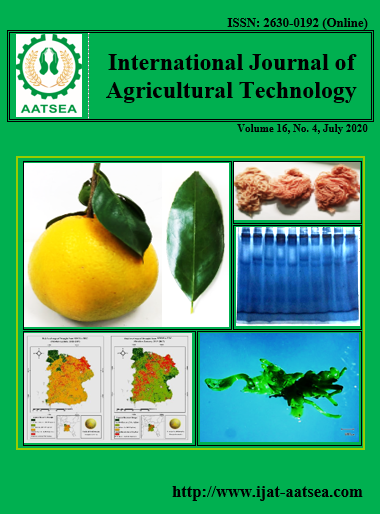Drought-tolerant characters, yield and its component of an elite landrace upland rice cultivars in Thailand
Main Article Content
Abstract
In Thailand, rice are cultivated on the rainfed unbunded upland environment about 0.928 million ha annually, which usually subject to drought stress due to an eratic rainfall throughout growing season, and usually having low yield stability and productivity. Two experiments were characterized a drought tolerant-related physiological traits, yield and its components of 6 elite landrace upland rice cultivars (Niaw Dum Luem Phua, Dawk Pa Yawm, hukaothong 2, Sew Gliang, Sam Deuan, and Leb Nok) with IR1552, and Khao Dawk Mali 105, a moderate drought-tolerant check varieties. The first experiment was carried out at King Mongkut’s Institute of Technology Ladkrabang, Bangkok during Aug-Sep 2018 for 4 drought tolerant-related characters at maximum tillering including longest root, root dry weight, root/shoot dry weight ratio, and stomatal conductance. The germinated seeds were grown in a cylindrical like-shape plastic pots, data were recorded for 10 hill/experimental unit. The second experiment was conducted at the experimental field of Rajamangala University of Technology Tawan-Ok, Chon Buri province, on loammy-sand, unbunded upland field under natural rainfed in rainy season (Jul-Nov), 2018. Ungerminated seeds were directly planted with space of 25x25 cm, yield and yield components were sampling recorded for 10 hill/experimental unit. All studied characters among cultivars; longest root, root/shoot dry weight ratio, stomatal conductance, yield and all yield components except, root dry weight were highly significant different (p≤0.01). IR1552 had the highest yield of 72.52 g/hill. Among 6 landrace cultivars, Niaw dum luem phua showed the highest drought tolerant-related characters, yield components, and rough yield of 59.77g/hill. While, Khao Dawk Mali 105 had rough yield of 51.42 g/hill.
Article Details

This work is licensed under a Creative Commons Attribution-NonCommercial-NoDerivatives 4.0 International License.
References
Highland Research and Development Institute of Thailand (HRDI) (2019). Upland rice. Retrieved from https://hkm.hrdi.or.th/knowledge/detail/273.
Kanbar, A., Toorchi, M. and Shashidhar, H. E. (2009). Relationship between root and yield morphological characters in rainfed low land rice (Oryza sativa L.). Cereal Research Communications, 37:261-268.
MacMillan, K., Emrich, K., Piepho, H. P., Mullins, C. E. and Price, A. H. (2006). Assessing the importance of genotype x environment interaction for root traits in rice using a mapping population II: conventional QTL analysis. Theoretical and Applied Genetics, 113:953-964.
Mishra, S. S. and Panda, D. (2017). Leaf traits and antioxidant defense for drought tolerance during early growth stage in some popular traditional rice landraces from Koraput, India. Rice Science, 24:207-217.
Ricepedia (2019). Rice productivity. Retrieved from http://ricepedia.org/rice-as-a-crop/rice-productivity.
Rice Department (2019). Rice varieties; Khao Dawk Mali 105. Retrieved from http://www.ricethailand.go.th/Rkb/varieties/index.php-file=content.php&id=19.htm.
Saito, K., Asai, H., Zhao, D., Laborte, A. G. and Grenier, C. (2018). Progress in varietal improvement for incressing upland rice productivity in the tropics. Plant Production Science, 21:145-158.
Song, Z. B., De-an, J., Ping, W., Xiao-yan, W., Qing, L. and Ni-yan, W. (2006). Relation of root growth of rice seedling with nutrition and water use efficiency under different water supply conditions. Rice Science, 13:291-298.
Tomita, M. and Tanisaka, T. (2010). Long‐culm mutations with dominant genes are induced by mPing transposon in rice. Hereditas, 147:256-263.
Usman, M., Raheem, Z. F., Ahsan. T., Iqbal, A., Sarfaraz, Z. N. and Haq, Z. (2013). Morphological, physiological and biochemical attributes as indicators for drought tolerance in rice (Oryza sativa L.). European Journal of Biological Sciences, 5:23-28.
Zu, X., Lu, Y., Wang, Q., Chu, P., Miao, W., Wang, H. and La, H. (2017). A new method for evaluating the drought tolerance of upland rice cultivars. The Crop Journal, 2017:488-498.


